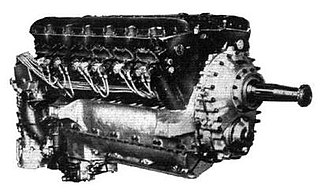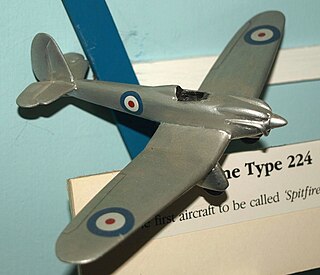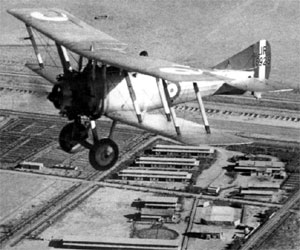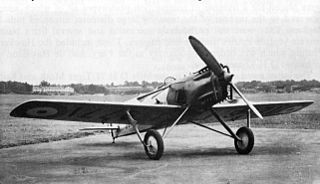
The Westland Welkin was a British twin-engine heavy fighter from the Westland Aircraft Company, designed to fight at extremely high altitudes, in the stratosphere; the word welkin meaning "the vault of heaven" or the upper atmosphere. First conceived in 1940, the plane was built in response to the arrival of modified Junkers Ju 86P bombers flying reconnaissance missions that suggested the Luftwaffe might attempt to re-open the bombing of England from high altitude. Construction was from 1942–43. The threat never materialised; consequently, Westland produced only a small number of Welkins and few of these flew.

The Hawker Nimrod was a British carrier-based single-engine, single-seat biplane fighter aircraft built in the early 1930s by Hawker Aircraft.

The Rolls-Royce Goshawk was a development of the Rolls-Royce Kestrel that used evaporative or steam cooling. In line with Rolls-Royce convention of naming piston engines after birds of prey, it was named after the goshawk.

The Hawker Horsley was a British single-engined biplane bomber of the 1920s. It was the last all-wooden aircraft built by Hawker Aircraft, and served as a medium day bomber and torpedo bomber with Britain's Royal Air Force between 1926 and 1935, as well as the navies of Greece and Denmark.

The Gloster F.9/37, also known as the Gloster G.39, was a British twin-engined design from the Gloster Aircraft Company for a cannon-armed heavy fighter to serve with the Royal Air Force, planned before the Second World War. The F.9/37 was rejected in favour of other designs.

The Gloster F.5/34 was a British fighter of the 1930s. It was a single-seat, single-engine monoplane of all-metal cantilever construction; the undercarriage was of the tailwheel type with retractable main wheels.

The Avro 604 Antelope was a British light bomber which was designed and built in the late 1920s to meet a requirement for a light bomber to equip the Royal Air Force, competing against the Hawker Hart and the Fairey Fox II. It was unsuccessful, the Hart being preferred.
The Hawker P.V.3 was a British single-engined biplane fighter prototype of the 1930s. Only a single example was built, the Gloster Gladiator being selected instead to fulfill the requirement to which it was designed.

The Supermarine Type 224 was an inverted gull-wing monoplane fighter aircraft designed by R.J. Mitchell at Supermarine in response to Air Ministry Specification F.7/30, which sought a fighter for introduction to succeed the Gloster Gauntlet. It was powered by the Rolls-Royce Goshawk engine, which used an experimental evaporative cooling system, and problems with this system, combined with its disappointing performance, led to it being rejected, a contract for production aircraft eventually going to the Gloster Gladiator. It is nevertheless notable because R.J. Mitchell learnt lessons from its failure that were to contribute greatly to his success with the Supermarine Spitfire.

The Gloster SS.35 Gnatsnapper was a British naval biplane fighter design of the late 1920s. Two prototypes were built but the type did not enter production.

The Nieuport Nighthawk was a British fighter aircraft developed by the Nieuport & General Aircraft company for the Royal Air Force towards the end of the First World War. Although ordered into production before the aircraft first flew, it did not enter large scale service with the RAF owing to unreliable engines. Re-engined aircraft did see service in Greece, serving from 1923 to 1938.
The Westland Yeovil was a British biplane bomber designed and built by Westland Aircraft in 1923 to meet an Air Ministry Specification for a single-engined day bomber.

The Westland Interceptor was a fighter developed by the British company Westland Aircraft to Air Ministry Specification F.20/27. When tested in 1929 and 1930, it showed unsatisfactory handling characteristics and was rejected by the RAF in favour of the Hawker Fury biplane fighter.

The Westland Wizard was Westland Aircraft's first attempt to produce a monoplane fighter. The project was privately funded and the prototype design was done in the spare time of the company's engineers. This all happened during 1926, with high-speed performance as the primary goal.

The Gloster TC.33 was a large four-engined biplane designed for troop carrying and medical evacuation in the early 1930s. Only one was built.

The Gloster TSR.38 was a single-engined three-seat biplane designed as a naval torpedo/spotter/reconnaissance aircraft in the early 1930s. It did not reach production and only one was built.

The Bristol Type 133 was a prototype single-seat, single-engine monoplane fighter, armed with four guns, metal-skinned and with a retractable undercarriage, built by The Bristol Aeroplane Co. to an Air Ministry specification in the mid-1930s. The single example crashed before the trials commenced.

The de Havilland DH.77 was a prototype British fighter aircraft of the late 1920s. Intended as a fast climbing interceptor for Britain's Royal Air Force, the DH.77 was a lightweight low-wing monoplane powered by a relatively low power engine. Despite excellent performance, only one aircraft was built, the Hawker Fury biplane being preferred.

The Westland Witch was an unsuccessful British bomber prototype, first flown in 1928. Only a single aircraft of this type was built.
The Blackburn F3 was a British single-engined fighter aircraft produced in response to Air Ministry Specification F.7/30.

















